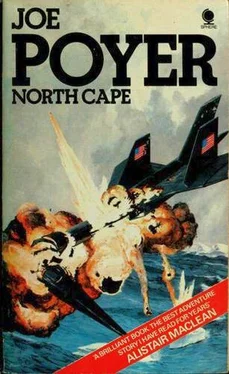Folsom interrupted Teleman’s thoughts as he spread out a more localized map of the North Cape and pointed to a small indentation on — the western side of the deep gash cut in the coastline by the Porsangerfjord. “This is the point where they landed. In this weather it will take them almost a day to travel far enough to reach the lifeboat. Now that Mac has had a crack at them, we can safely assume that we’ve gained another six to eight hours while they chase themselves through the boondocks after the phony trail he left behind. But we have now used up nearly four hours of that time. So, all in all, we are probably still five hours ahead of them, until they get far enough along the coast to spot the lifeboat.
“Now,” he said, staring speculatively at Teleman, “the Russians probably had a darn good idea where you were. But until Mac hit them they probably had no idea you had any help at. all. We. can-expect them to be confused for a while, wondering how many others are waiting in ambush along the way. I think we can consider the RFK as a hole card — although whether a joker or an ace is hard to tell at this point.”
“You know, Pete,” Gadsen interrupted, “if we do get into enough of a bind that we do have to call the Norwegians for help, that damned sub could very well be monitoring for just such a transmission. If that happens, they will probably just move in and shell the. hell out of us. They must be carrying some kind of — deck gun or surface-to-surface rockets.”
“Yeah, I thought of that too. If we do have to call on the Norwegians, it will be up to the captain to decide whether he wants to open fire on the sub Or not. If he does, there will. be no way of hiding the fact. Talk about conditions for an international incident, whew!”
“Kind of in a bind ain’t we, then?”
“Precisely, so lets git. Here’s our destination,” he said, pointing again to the base, marked on the map in red. “We had better move out of these trees and onto the cliffs. It will be rougher going, but we can follow the coastline for a while. About here it turns into tundra, which should be swept pretty free of any deep snow.” He indicated a point about six miles down the coast. “There, I expect, it’ll be a toss-up whether or not the tundra is passable. If so, we go across. If not, we follow the coast.” Teleman leaned closer to examine the chart. It showed an irregular jut of land that bulged around the tundra for a distance of nearly thirteen miles. The contour lines on the chart indicated that the bulge was composed mainly of steep crags and shelving granite, leading to a sharp drop of fifty feet or so to the water. Once past this bulge, the land flattened again to narrow beach and even narrower pine-and scrub-covered terrain fronting the tundra.
“Pray for the tundra,” he murmured. “That climb around the point will be hell.”
“There is one other possibility,” Folsom said thoughtfully. “I had thought of heading south to Kistrand at the head of Porsangerfjord. The only trouble with that is this range of hills, just about here. They rise to a little over a thousand feet in less than the two miles between us and the town. And the only pass or anything resembling a pass leads west, and then south for a total distance of thirty-five miles. According to the map, the pass is at eight hundred feet. Teleman could never make it.
“So then, the only choice we have is to go west toward the naval station at Tanafjord. If the weather breaks, the ship will be able to reach us with the helicopter on the way.” Teleman nodded acquiescence. “All right. If it turns out that somebody has to carry me, don’t say I didn’t wain you. Either.carry me or shoot me,” he added, looking sharply from face to face. He thought he saw a faint tinge of surprise in Folsom’s eyes, but he could not be sure. It did not make any difference, he thought. He must watch all three of them closely now.
Folsom smiled. “All right, we’ve been warned. But don’t worry about it. Even if we do have to carry you, we will get you back, one way or another.” The executive officer stood up. “Okay. We head out in five minutes. Julie, pass out those snowshoes.”
Gadsen got up and pulled out four pairs of make-shift snowshoes from under the pile of gear on his side of the tent and passed them out.
“Sorry about the pack frames,” he apologized, “but I figured sore shoulders were better than tired legs.”
The snowshoes were made from aluminum bracing taken from the Himalaya mountain packs. Gadsen had straightened the frames and bent them into rough circular shapes, then used nylon line for webbing and the rough bootstraps. They were clumsy, but would serve to keep the wearer on top of, rather than floundering knee-deep in, the snow. While Teleman pulled on a pair of insulated boots over two pairs of heavy wool socks and one pair of felt underboots, McPherson and Folsom loaded the gear and sleeping bags into the packs. Then he pulled his dacron parka tighter and zipped it close to his throat, pulling the hood up and tying it tightly. Around his neck went a six-inch flap that snapped in back, covering chin and throat. Folsom handed him a face mask, which he snapped to the throat flap and along the rim of the hood.
“I feel like a man from Mars,” he muttered through the muffling fabric. The others looked much the same.
“The very best Arctic gear the U.S. Navy has, Major.” McPherson laughed. “Once we get outside, you’ll wonder why the damned clothing couldn’t be warmer. Me, I intend to write a letter to Naval Supplies when I get back, telling them just what I think of this stuff.”
Folsom looked Teleman over carefully. “How do you feel now?”
“To he truthful, pretty weak. But I think I can make it.” Folsom undid a pocket flap on his pack and pulled out an aluminum tube. “Try a couple of these, Benzedrine. They’ll pick you up.”
“Yeah, I know. But I’ll wait awhile.” Teleman wondered if Folsom had any idea what effect that Benzedrine would have on him. “No sense exhausting myself too early.” Folsom nodded. “Yeah, I guess you’re right.” He turned and quickly looked over the other two. “All right, let’s move out.”
They broke camp quickly, each man carrying a carbine, canteen, and thirty-pound pack, with the exception of Teleman. He insisted that he carry at least his own carbine and the tent. Reluctantly, McPherson gave it to him. The tent folded into a compact package weighing less than ten pounds, but even so McPherson knew that in his weakened condition the extra ten pounds would soon begin to weigh on Teleman like ten thousand.
Folsom took the lead. Head down, and with the queer shuffling gait that snowshoes force, he struck out through the scrub forest toward the cliffs at a steep diagonal. The snow was deep and the wind whistling through the trees swept at them from every direction, dumping snow from the laden branches onto the four men trudging below. Folsom led them around the deepest drifts, sticking to the open areas as much as possible so that the drifting snow would thoroughly cover their tracks.
It took them an hour to walk out of the trees and reach the cliffs. An hour of tense shuffling on the round snowshoes that cramped muscles unknown to Teleman until then. The width of the snowshoes forced him to walk with his legs farther apart than he was used to, and shortly the muscles on the inside of his thighs were screaming for relief. And the dense underbrush made the walking that much harder. Bushes, half hidden in the snow, caught at the rims and webbing of the shoes. Within the first hour Teleman had fallen twice.
As soon as they stepped from the tree line, the full force of the wind caught them squarely. Snow, swirled up into a ground blizzard, stung at their eyes and any exposed skin surface, finding its way inside snow masks, around the elastic wrist and ankle bands and between hood and parkas with an insidiousness that was almost human. It had been Folsom’s intention to strike west along the rim of the cliffs as long as they lasted, but the ground blizzard, whirled into a fog of ice crystals, made travel along the cliff tops too hazardous. It would have been very easy to walk over the edge before realizing it. McPherson led them back away from the cliffs for fifty yards and, bent into the rising wind, they moved parallel to the line of cliffs, using their meager lee for what shelter that could provide from the gale-force wind.
Читать дальше












